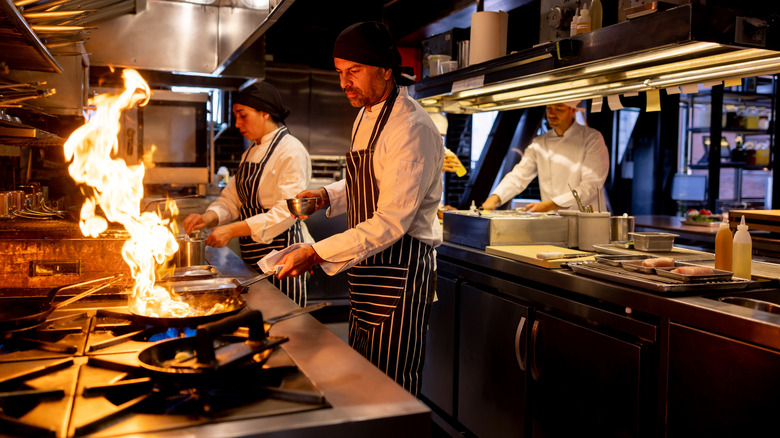The Restaurant Industry Job Pool Has Returned To Pre-COVID Levels
Don't call it a comeback. More than three years after the pandemic rocked the restaurant industry, things might be finally returning to "normal."
Back in 2020, one in four people who got laid off at the start of the pandemic worked in a restaurant. Now, in a major tide shift, September 2023 alone saw 60,700 new jobs in "eating and drinking" establishments, according to the Bureau of Labor Statistics, via QSR. Industry-wide, restaurant revenue seems to be gradually increasing, as well. In August, nationwide restaurant sales hit $90.8 billion, up 0.3% from July's $90.5 billion. It's slow growth, to be sure, but it's demonstrative of a larger consistent positive trend. Earlier this year, Forbes reported that fine dining restaurant reservations have returned to pre-pandemic levels. At establishments across the board, 27% of foodies said they've been patronizing restaurants more often than they used to.
Restaurant employment has been gradually increasing as the labor shortage begins to ease. But, with that resurgence of workers has come a revolutionary wave of workers' rights and increased union activity. Mandatory minimum wage increases are just the beginning. Earlier this week, Chicago's City Council voted to eliminate the tip credit, meaning the city's tipped restaurant workers will receive the same minimum wage as any other industry employee, before tips. In short, food service jobs are getting more attractive by the day (a long overdue shift).
Stepping into a new industry
As glossy as this news might sound, returning to pre-pandemic levels doesn't necessarily mean returning to pre-pandemic conditions. Employment prospects and restaurants have changed as the industry has recovered.
The pandemic created a greater focus on production than in-person service as carryout and delivery have increased. Even as pandemic-related restrictions lift, the trend is moving away from sit-down dining. 41% of restaurant patrons say they're more inclined to order carryout now than in 2019. As a result, third-party app-based food delivery drivers have seen a new wave of workers' rights ordinances in recent months, as well. On a larger scale, the shift from a face-to-face industry to a digital one has come with other issues. Negative online reviews can decrease employee morale and dramatically harm businesses' traffic and reputation (which can negatively affect income for tipped workers).
Similarly, just because the pandemic is over doesn't mean that the post-pandemic world hasn't arrived with its own problems. Inflation and supply chain issues remain high. After factoring in inflation, restaurant sales have only increased by 1.8% from August 2022 to August 2023. Even though prices have been rising for customers, businesses haven't been seeing any more profit. While employment is slowly restored, some establishments have reduced their hours to offset the cost of labor and daily operations. A Datassential report from October 2022 found that, on average, restaurant operating hours nationwide were still 7.5% shorter compared to 2019, the equivalent of roughly 6.4 fewer hours per week.

